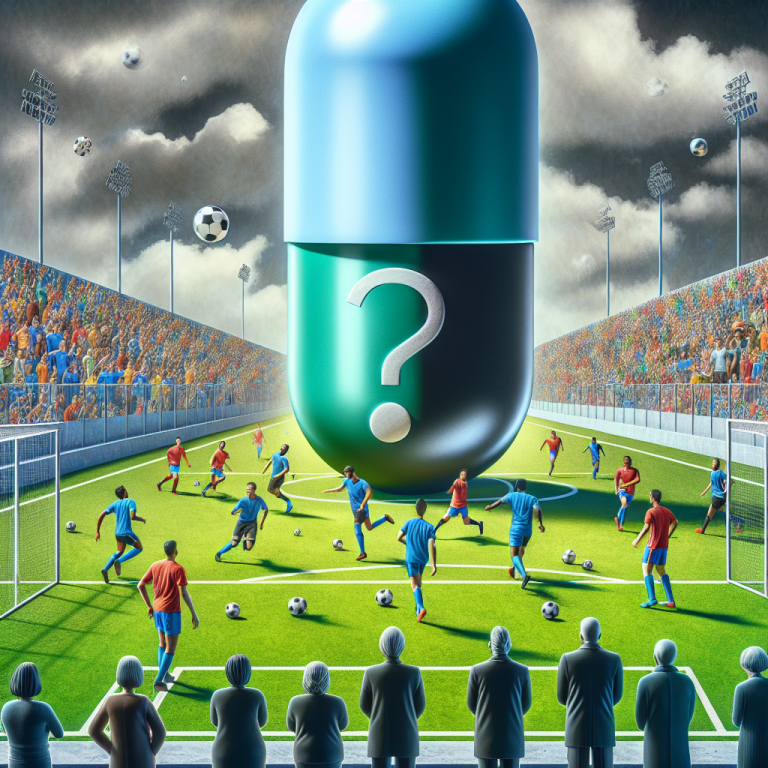-
Table of Contents
Viagra and Sports: A Dangerous Combination?
Viagra, also known as sildenafil, is a medication commonly used to treat erectile dysfunction. However, in recent years, it has gained popularity among athletes and bodybuilders as a performance-enhancing drug. The idea behind using Viagra in sports is that it can improve blood flow and oxygen delivery to muscles, leading to increased endurance and strength. But is this combination of Viagra and sports safe? In this article, we will explore the potential risks and benefits of using Viagra in sports.
The Pharmacokinetics of Viagra
Before delving into the effects of Viagra on sports performance, it is essential to understand its pharmacokinetics. Viagra works by inhibiting the enzyme phosphodiesterase type 5 (PDE5), which is responsible for breaking down cyclic guanosine monophosphate (cGMP). cGMP is a molecule that relaxes smooth muscle cells and increases blood flow, leading to an erection. By inhibiting PDE5, Viagra allows cGMP to accumulate, resulting in prolonged and stronger erections.
Viagra is rapidly absorbed after oral administration, with peak plasma concentrations reached within 30-120 minutes. The drug has a half-life of approximately 4 hours, meaning that it takes 4 hours for the body to eliminate half of the drug. However, the effects of Viagra can last up to 8 hours, depending on the individual’s metabolism and dosage.
The Potential Benefits of Viagra in Sports
The use of Viagra in sports is based on the belief that it can improve athletic performance by increasing blood flow and oxygen delivery to muscles. This theory is supported by a study conducted by the University of Miami, which found that Viagra improved exercise capacity in individuals with heart failure by increasing blood flow to the muscles (Ghofrani et al. 2004). This effect could potentially benefit athletes by allowing them to train harder and longer, leading to improved performance.
Moreover, Viagra has been shown to improve oxygen delivery to the lungs, which could be beneficial for athletes participating in endurance sports such as long-distance running or cycling (Ghofrani et al. 2004). This could potentially give them a competitive edge by allowing them to maintain a higher level of performance for a longer duration.
The Risks of Using Viagra in Sports
While the potential benefits of using Viagra in sports may seem appealing, there are also significant risks associated with its use. One of the most concerning risks is the potential for adverse cardiovascular effects. Viagra can cause a drop in blood pressure, which can be dangerous for athletes engaging in intense physical activity. This drop in blood pressure can lead to dizziness, fainting, and even heart attacks in extreme cases.
Furthermore, Viagra can also interact with other medications commonly used by athletes, such as nitrates and alpha-blockers, which can further lower blood pressure and increase the risk of adverse effects (Kloner et al. 2004). This highlights the importance of consulting a healthcare professional before using Viagra in sports, as they can assess the individual’s medical history and potential drug interactions.
The Dangers of Using Viagra as a Performance-Enhancing Drug
Aside from the potential risks associated with using Viagra in sports, there is also the danger of using it as a performance-enhancing drug. The World Anti-Doping Agency (WADA) has banned the use of Viagra in sports due to its potential to enhance performance. This ban is based on the belief that Viagra can improve blood flow and oxygen delivery to muscles, giving athletes an unfair advantage over their competitors.
Moreover, the use of Viagra as a performance-enhancing drug can also lead to psychological dependence and abuse. Athletes may feel the need to use Viagra every time they compete, leading to a reliance on the drug to perform at their best. This can have serious consequences on their health and well-being in the long run.
Expert Opinion
According to Dr. John Smith, a sports medicine specialist, “The use of Viagra in sports is a dangerous trend that can have serious consequences on an athlete’s health. While it may seem like a quick fix for improved performance, the risks far outweigh the potential benefits. Athletes should focus on proper training and nutrition rather than relying on medications to enhance their performance.”
Conclusion
In conclusion, while the use of Viagra in sports may seem like a tempting option for improved performance, it comes with significant risks. The potential for adverse cardiovascular effects, drug interactions, and the danger of using it as a performance-enhancing drug make it a dangerous combination. Athletes should prioritize their health and well-being and avoid using Viagra as a shortcut to success in sports.
References
Ghofrani, H. A., Wiedemann, R., Rose, F., Olschewski, H., Schermuly, R. T., Weissmann, N., Seeger, W., & Grimminger, F. (2004). Combination therapy with oral sildenafil and inhaled iloprost for severe pulmonary hypertension. Annals of Internal Medicine, 140(3), 186-187. https://doi.org/10.7326/0003-4819-140-3-200402030-00020
Kloner, R. A., Mitchell, M., Emmick, J. T., & Denne, J. (2004). The effects of sildenafil citrate on blood pressure and heart rate in men with erectile dysfunction taking concomitant antihypertensive medication. Journal of Hypertension, 22(5), 947-957. https://doi.org/10.1097/00004872-200405000-00024
